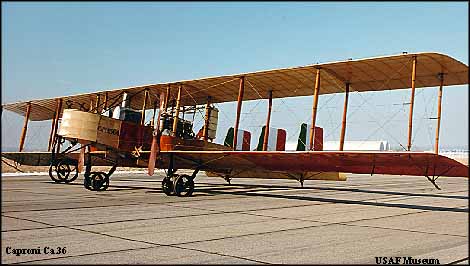|
In late 1914 Italian aeronautical engineer Gianni Caproni developed a three-engine bomber, the Ca.31 powered by three Gnome rotary engines. The following year Caproni produced a new version - the Ca.32. It was very similar to the Ca.31 but with three FIAT 100 horsepower water-cooled in-line engines. Three months after Italy's entry into WWI, the first Ca.32's attacked an Austrian airbase at Aisovizza and by the end of the year regular raids were being mounted against other Austrian targets. Caproni continued to refine his successful design with the introduction of the Isotta-Fraschini powered Ca.33. The Isottas produced 150 horsepower and were generally more reliable than the FIATS. Toward the end of the war the definitive version, the Ca.36 went into production. Changes from the Ca.33 were small but included 5-section wings which made for easy disassembly and surface transportation. Ca.36 aircraft remained in Italian Air Force service as late as 1929. The Ca.36 on display was obtained by the USAF Museum in 1987. It was restored at the Museum and is on loan from the Museo Aeronautica Caproni di Taliedo in Italy. |
 |
|
| SPECIFICATIONS
Span: 74 ft. 7 in. Length: 36 ft. 3 in. Height: 12 ft. 7 in. Fuel Capacity: 166 gallons Oil Capacity: 13 gallons Weight (empty): 5733 lbs. Weight (loaded): 8820 lbs. Armament: Two Revelli 6.5mm machine guns Bomb Load: 1764 lbs. Engine: Three Isotta-Fraschini V.4B 150 hp. water-cooled , 6 cyl. Crew: 4 PERFORMANCE Maximum speed: 87 mph. Rate of climb: 3281 ft. in 8 minutes Rate of climb: 13,124 ft. in 65 minutes Range: 372 miles Service Ceiling: 14,765 ft.
|
||